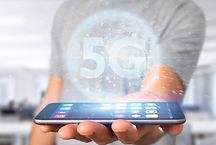
App Trends 2023: You should know them
Twelve trends in app development
Mobile apps are a growth market that opens up immense business opportunities for providers - B2C or B2B. The latest app trends point toward need-based, future-oriented applications that give companies a competitive edge.
As the German Mobile App Trends Report also shows, the growth of mobile applications has continued to accelerate powerfully. One of the factors responsible for this is the strong demand for
- Fintech apps, which have seen a significant year-over-year increase in installs (from up 16% in EMEA to 69% in North America)
- E-commerce apps (up 12% across all markets, with EMEA leading the way with an 18% increase)
- And gaming apps, with hyper-casual games accounting for the largest share of installs at 27% (for gaming apps overall, LATAM and EMEA saw the most significant growth rates at 35% and 33%, respectively).
Although some trend researchers predict the end of the app era and the rise of bots, the numbers speak a different language. As the following app trends impressively demonstrate, unprecedented opportunities for development work are opening up today thanks to smart technologies and the popularity of mobile apps in almost every field and for every purpose. These are the trends in app development in 2023:
App Trend #1: Internet of Things (IoT)
The Internet of Things (IoT) is undoubtedly one of the top trends in app development, if not the most important trend. After all, the world is becoming increasingly connected, and the curve for spending related to IoT has been pointing steeply upwards for years. There is no end in sight for the time being. More and more people - whether for private or business purposes - are using smartphones or smartwatches to control networked devices via apps conveniently. In the private sector, smart home applications, including controlling consumer electronics such as music or TV, are becoming increasingly popular. In the business world, the trend is toward more and more networking; we have long since arrived in the age of Industry 4.0, sometimes also called the Industrial Internet of Things (IIoT). There are already almost no limits to the networking of users, processes, and devices - whether in logistics processes, production, or maintenance and repair. More and more companies are using IoT technologies to make processes faster and more efficient. The control system is primarily mobile. The IoT will continue to be a hot app trend in the coming years.
App Trend #2: Artificial Intelligence and Machine Learning (AI & ML).
In the private sector, AI & ML became mass-market through assistants like Siri and Alexa. But today and in the future, intelligent software functions go far beyond that. Especially in B2B, intelligent apps are already the standard in many areas and industries - a trend in app development that is red-hot and will remain. Predicting patterns based on Big Data can create personalized experiences, automate tasks, improve security, and more. Use cases for AI & ML in apps abound, some of which include:
- Chatbots
- Automated warehouses, such as those at Amazon
- Sound recording apps in manufacturing that broadcast acoustic anomalies from machines
- Smart logistics apps
- Predictive maintenance apps.
- Predictive analytics for personalized recommendations in m-commerce
- Voice recognition apps
- Security apps with facial recognition for fraud prevention
Smart features make for powerful apps that make life easier for end users and, in B2B, help companies make processes more efficient and provide a better user experience for their customers. A huge market and one of the top trends in app development.
App Trend #3: Mobile Commerce (M-Commerce)
With mobile devices, purchases via mobile apps (m-commerce) are also on the rise. In B2C, many companies have long since set up their online stores, including store apps, to market their products independently of platforms such as Amazon. But m-commerce has also conquered the B2B sector and is becoming increasingly popular there. An enterprise app for a storage system that uses new technologies such as AI and ML and integrates valuable information from other systems via interfaces can be a competitive advantage for B2B companies. This is because it improves the customer experience, enhances the user experience, and helps improve conversion rates. The demand for mobile applications for m-commerce is constantly increasing - which is why the app trend is likely to continue.
App Trend #4: Gamification

Another trend in app development involves gamification: users should be able to use B2B apps as intuitively and playfully as they are used to in their private lives. That's why app developers should model their micro apps on B2C apps in terms of look-and-feel and usability. B2B customers thus reap significant benefits, such as greater acceptance of app use among their employees, shorter training times, less training effort, and lower costs - compared to the introduction of a complex mobile application.
App Trend #5: Augmented Reality (AR) Apps
AR apps are used to combine virtual information with reality. They have now become ubiquitous in the B2C sector: For example, consumers test whether a new pair of glasses, clothes, or makeup would fit their person or how a couch or lamp would look in their home. This app trend has fully taken hold in private life and still offers a lot of potential in B2B. It is essential to exploit this potential by having programmers take up this trend in app development and implement it in line with requirements. AR can be used, for example, to create unique customer experiences, to better present products before they are purchased (for example, when the AR function is linked to product information management, or PIM), and to tell stories (such as in the travel and tourism sector) that set companies apart from the competition. AR glasses help employees in production, picking, or assembly to complete their tasks quickly, efficiently, and with quality assurance based on superimposed information.
App Trend #6: Modularity, Integration, Fluidity
Today, users work with various apps, usually in parallel. One of the most critical trends in app development must be that app providers make this user behavior as easy as possible for their customers. But how can this be achieved? On the one hand, it's a matter of keeping the apps as lean as possible through modular design. This is because switching back and forth between modules of individual applications is much faster than between cumbersome apps overloaded with various functions and consuming vast amounts of storage space. It is even more convenient for the user not to switch but to find different tasks in one app as needed. Anyone who uses a business network will probably also want to chat, so users will also find a chat function on LinkedIn, for example. One app trend is, therefore, to increasingly blur the boundaries between applications. It is not enough for a provider to develop an attractive app to achieve this. Instead, it is essential to focus on the functions during app development and to consider how these can interact as smoothly as possible with functions or modules of other applications.
App Trend #7: Instant Apps (also known as PWAs)
The future belongs to browser-based applications, so Instant Apps, also known as Progressive Web Apps (PWAs), are among the important app trends. This is true in the B2C as well as in the B2B sector. An instant app or PWA is not so much an app as a responsive website that users can access via any mobile device. Unlike a native app, the user does not have to download anything and therefore does not need any storage space on the smartphone and/or tablet. For example, if the user wants to test different services in parallel, he leaves the instant app open for as long as he needs it. When the app is closed, it disappears similarly to a website. For the provider of an instant app, it is more likely to be convincing at first go than with a native app, which, once downloaded, may still be used, even if it took some getting used to.
Instant apps combine the advantages of websites, such as the possibility of search engine optimization, with native apps, such as fast loading times, offline mode, or push messages. They are not tied to any operating system and cannot be posted in app stores. This has both advantages and disadvantages for the provider: On the one hand, he can do without developing different variants for the respective app stores; on the other hand, he has to take care of the marketing of his application himself.
Particularly in B2B, companies should embrace this trend in app development and use their microapp to stand out from the competition and address customers with personalized content. Instant apps are much faster-moving than native apps due to the lower development effort. So providers should always keep an eye on the competition and regularly update their app - a welcome occasion to get in touch with customers.
App Trend #8: 5G

A fast 5G network is a crucial trend in app development. This is because it makes integrating augmented reality (AR) and instant apps possible in the first place. 5G is the prerequisite for high-performance, efficient apps and creates a lot of potential for the functionalities of mobile apps. For example, significantly more devices - namely up to 1 million per square kilometer - can communicate with each other at high speed than is possible with 4G. This is a potential that app developers should not leave unused in the IoT age. This applies to B2C as well as B2B: Just think of smart home applications in which devices such as heating and air conditioning systems, roller shutters, and surveillance cameras are networked and can be controlled via a mobile app. In commercial buildings, the principle is the same, except that other devices are components of an even more extensive network. Another example is in industrial companies, where machines in production exchange data and remain controllable and monitorable via the app.
5G is an app trend and a dream of the future because it is still not a global standard. Even in Germany, the fast network is not yet available everywhere. This is a stumbling block that providers should be aware of.
App Trend #9: Beacon Technology
Beacon technology is spreading rapidly and, therefore, one app trend that providers should not ignore. According to Statista, the global market value of beacons is expected to increase tenfold from 2016 to 2026 to more than $56 billion. Beacons are small devices consisting of a battery, CPU, and transmitter. They bridge the gap between the online and offline worlds: retailers can install them to collect information about customer behavior in the store. Beacons use Bluetooth to contact the customer's smartphone and send them relevant information about products of particular interest.
But beacons are more than just a marketing tool for retailers. They are already being used in other industries as well: Examples include beacons as guidance systems for the blind and indoor navigation at airports, as audio-visual guides in zoos, museums, and exhibitions, or as transmitters in Factory 4.0, which trigger warning signals to avoid errors in production. The potential of this app trend for use in B2C and B2B is immense.
App Trend #10: Blockchain Technologiegy
In times of increasing cybercrime, blockchain technology is an app trend that providers should have on their radar when developing an app - for their own store system, for example. This is because more and more customers are paying via mobile apps and blockchain technology ensures greater payment security. Put simply; the blockchain is a chain of data records that is mirrored on each user's computer or smartphone. Decentralized data storage makes it more difficult for hackers to tap sensitive data.
It is true that blockchain and cryptocurrencies such as Bitcoins and Ethereum, which are used as a means of payment, are still in their infancy. But the first providers of mobile payment services (mobile wallets), such as Paypal, are already offering payment by cryptocurrency, albeit only in the USA for the time being. Why not take a cue from them? For programmers, adopting blockchain as a trend in app development means integrating the technology into the checkout process of the online store app, for example, and thus enabling customers to make quick, easy, and secure payments.
Blockchain also has potential in Industry 4.0 - for improved supply chain management, for example. If everyone involved in the logistics process - for example, when delivering freight - has access to all relevant data via app and blockchain, this ensures faster, more efficient processes.
App Trend #11: Apps for Foldable Devices
Another app trend that programmers should be aware of is optimizing mobile apps for foldable devices. These are on the rise because more and more people want to use large displays - whether in B2C or B2B: When it comes to gaming, playing videos, using streaming services, or in B2B to be able to see multiple apps at once and switch seamlessly with features like Multi Window, devices with large screens are clearly superior. Foldable displays are a challenge for app development because the app must seamlessly adapt to the folded or unfolded display. In addition, it is important to consider which information should be offered in the cover display and which in the main display. Optimization for foldable devices is a trend in app development that has already picked up speed.
App Trend #12: Apps for Wearable Devices / Wearables

More and more people are using wearable devices (wearables) such as smartwatches or fitness trackers: according to Statista, global sales have increased more than tenfold since 2014. It is logical that this also increases the demand for special software for wearable devices. An app trend that providers should embrace in light of this development. Apps for wearables hold great potential for both private and business customers. As fitness bracelets, control centers in the Internet of Things (IoT) as well as in the innovative home sector or Industry 4.0, they ensure the networking of users and their environment and thus fast access to information or more efficient processes and more excellent work safety. In B2B, AR or data glasses are also gaining acceptance - for example, in maintenance and repair, in warehouses, or in production.
What Should Providers Pay Particular Attention to in App Development?
The trends in app development described above show that there is a lot for providers - whether for B2C or B2B - to consider if they want to develop contemporary apps that meet their needs.
1. First and foremost, customer needs must be brought into sharper focus. Keywords here include the app trends fluidity, gamification, apps for foldable devices, and m-commerce: In times of multiple apps on one display, customers want apps that are easy to use, integrate functions, and support fluid switching back and forth. When it comes to mobile shopping, customers are happy to see their shopping experience enhanced by smart features. It is important to put customer needs and features at the center of development work rather than the goal of programming a state-of-the-art app with multiple functions.
2. Powerful apps thrive on modern technologies, so embracing new technologies and staying on the cutting edge is crucial. This includes instant apps, 5G, beacons, and AR. Technology is not an end but must always create added value for customers.
3. To meet essential criteria such as performance, user-friendliness, and data security, it is imperative to test apps extensively during development. This includes functional and non-functional tests such as checking responsiveness, performance, offline support (for instant apps), or cross-browser tests. Depending on the function of an app, other tests are in the foreground; for m-commerce apps, testing of payment functions and security tests are more relevant.
4. Last but not least, there is the decision of whether companies want to develop their enterprise app themselves or have it set. It can be helpful to enlist the support of an experienced service provider with a proven process for app development.
Conclusion: Include App Trends in Development Work
Mobile apps have conquered nearly all areas of personal and business life and continue to boom. But the market is highly competitive and development cycles are short. If providers manage to pick up on the latest trends in app development in a way that suits their market and customer groups, then they will score points against the competition now and in the future. The most important thing here is a function- and user-centric mindset and the integration of new, intelligent technologies.
Written by
